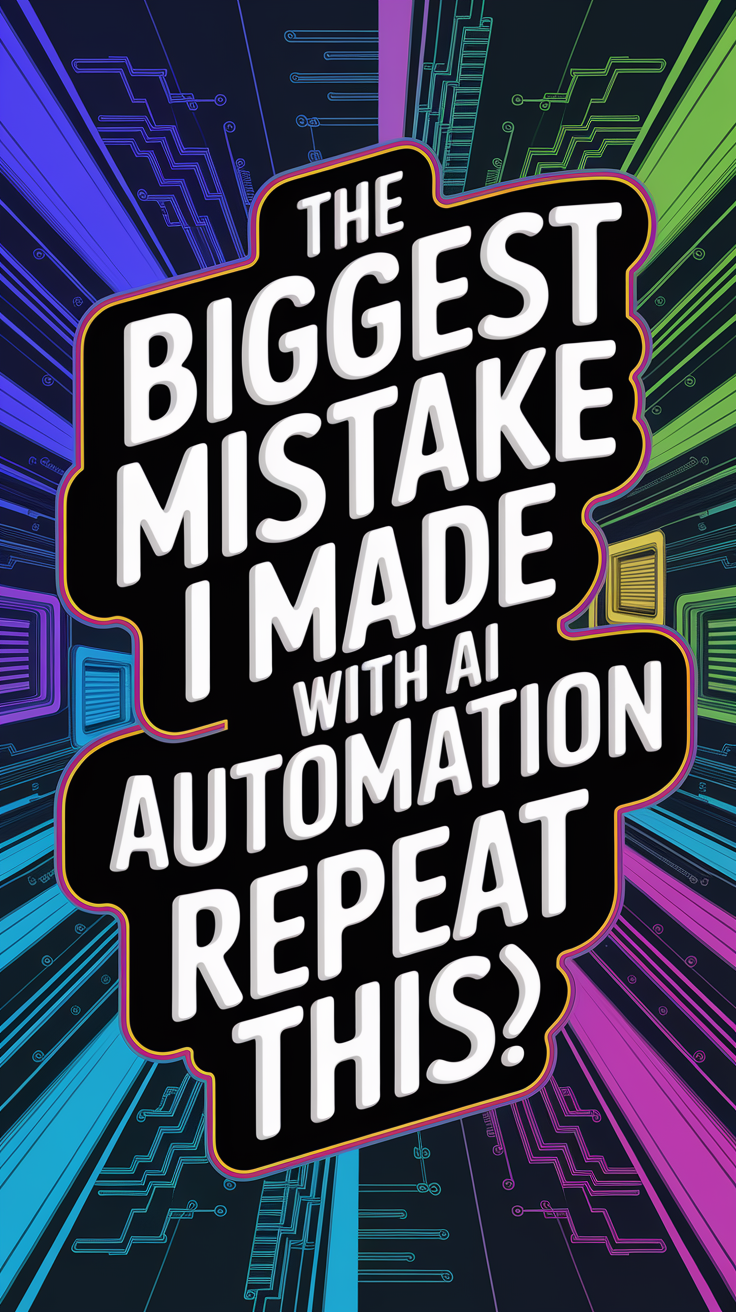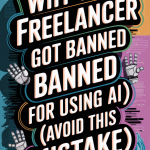Like most people, I dived headfirst into AI automation early on, empowered by the buzzword gold rush. Frankly, it baffled me that something so seemingly intelligent and complex could, in my experience, backfire spectacularly, costing us time, sanity, and revealing just how little many AI tools absolutely get about the human dimension of work – and life.
My background? A mix of tech experience, seeing my Haitian family’s struggles navigating pathways to a better future often involves planning and detail – tasks suddenly being automated without considering the pitfalls. Before I tell you about my costly misfire, let’s consider the AI hype first: scratch a tech executive or headline writer, and you just might find code generation, chatbot personalities, and AI art du jour. But real-world application requires more than clicking a button labeled "Optimize."
The Hype vs. The Heat: My Misguided AI Automation Adventure
A while back, I was consulting independently for a mid-sized tech company. My task? To analyze and report on their customer support email data for identifying recurring issues and improvement areas. The dataset was large and required natural language processing. Enter intelligent automation – chatbots, sentiment analysis AI, data ingestion processes. Excitement was sky-high.
I chose an off-the-shelf, feature-laden AI "dashboard" tool. It promised: sentiment analysis, reply generation, keyword topic modeling, automated tagging – all in one place, AI-assisted. It sounded revolutionary, didn't it?
Here’s the reality check I should have received by reading the fine print: this tool worked optimally when faced with data that was clean, structured, and in the format it was trained on. They got customer-facing documents, free-form emails, and call transcripts. It’s hard to overstate the mess my client's emails were. Hundreds of thousands of them, spanning years.
What Went Horribly Wrong (Hint: It Had Nothing to Do With Sentiment)
Lets cut straight to the chase – the mistake wasn't that it automated. The mistake was it standardized, generalized, and simplified, often to the dimmest of senses, without validation.
Specifically: The system's AI happily labeled customer emails "Negative" based on the mere occurrence of words like "problem" or "issue". But the truth? Many contained enthusiasm for a resolution or, more common – they were simply vague questions, complaints about another unrelated service, or even marketing junk email!
It assigned the simplest possible resolution template, often a canned response, whether there was any relevance at all. This wasn't just poor output; it was actively inadequate intelligence filtering. It didn't understand context, nuance, or the specific language my clients used. And worse, when the automated output was wrong or useless, it had no mechanism to flag it for human review.
The human team trying to implement this automation spent around-the-clock building dashboards based on the AI's outputs. We got hundreds of what appeared to be actionable insights – only to realize that 90% were either wrong, misleading, or flat-out hallucinated. We had visualizations propagating errors. The system had essentially taught our team to rely on a flawed process, creating bias where none existed before.
This is the operational risk we shipped. People acting on false information. This isn’t science fiction; it’s the modern data equivalent of claiming you can accurately measure the temperature all day just by using your oven.
Lessons Learned: The Human Oversight Imperative
You thought automation was about offloading work? Sure, but my experience says its core function must be chosen and deployed with profound
- Validation: One-size-does-not-fit-all. No tool understands your unique domain like you do. AI might see language patterns, but it won't know what "resolution-ready" looks like within your industry. Regardless of AI promises, manual validation loops are unavoidable steps.
- Anthropomorphization Control: AI needs to be a tool, not a master. When I thought the system knew the true meaning of an email, it was simply generating probabilities. When things go wrong, it becomes the "he" or "she" rather than our responsibility. Keep it grounded.
- "Garbage In, Crap Out" Especially Applies to AI: No system is truly magical. Feeding it messy or irrelevant data doesn't magically clean it up. Ensure your input is at a reasonable quality first. Then watch the output appraisal.
- Finite ROI: Automation just for the heck of it? Few results. Identify specific, measurable, and achievable outcomes. Is the $60+ CAD study on customer intention in the Quebec market worth better tools for analyzing feedback? Only you can judge.
Beyond My Fumble: The Deeper AI Automation Pearl Harbor
This wasn't just my bad call, or this specific company's flawed setup. It's symptomatic of the current AI over-adoption situation.
When tech teams, marketers, or managers hear "AI", they lactate on a dream of digital efficiency. But the tools often haven't proven ready for prime time that needs to survive human scrutiny. Furthermore, the AI industry itself has a co-option of language, positioning systems as self-aware, autonomous agents – when legally, ethically, and practically, they are highly complex probability engines.
Are you falling for the "AI transformed everything" narrative?

Your Action Plan for Safer AI Usage (Not Just Faster Cans of Spam)
Before you run off and integrate a new AI service, stick with these guiding principles:
- Boundaries: Define what success looks like before even thinking about automation. Can you explain it to an outside person without diagrams?
- Pause: If the AI vendor's mission statement sounds more poetic than operational, flag it. Real AI doesn't "feel", it calculates.
- Hybrid Approach: Often, success lies in hybrid methods – AI for suggestions, yes; primary decision maker, certainly not. An ounce of human scrutiny is worth an empire's worth of "intelligence" sometimes.
Think of it like assembling furniture – AI offers the box and some really pretty arrangement charts. Building it right still requires following those instructions carefully and paying attention when something doesn't click. Don't let the hype noise drown out the clarity required in execution.
AI's Place in Our World: Not Evil Overlord, But Highly Capable Assistant
AI won't fix your immigration paperwork (though it might structure it much better) or your financial budget (though it might count the numbers faster). But, when properly guided, applied diligently, with real validation, and fully human-driven oversight, AI holds promise. My mistake was treating it like another software upgrade and letting the hype machine steer my decisions, rather than my professional judgment.
The truly excellent AI systems we value today are extensions of human need and effort, not replacements born of paradoxical faith. This requires discipline – discipline we can't afford to lose.
Disclaimer: On Ethics, Errors, and Edits
This story involves sensitive client information that is fully anonymized and was the basis for my professional introspection. Errors and AI tool misclassifications involve real human consequences, often oversimplified in public stories. It’s crucial to consider such application risks carefully.
If you're trying to purchase AI tools for your business or as a student (maybe for a study on customer retention in Halifax?), consider what your specific needs are. Don't mass-buy based purely on brand – do your own validation. Remember, it's not about getting "smarter". It's about getting SMARTER EFFICIENT, not replacing – the human advantage must remain strong. The best is often better automation than simple. Use wisely.
Where can you find the latest updates on community happenings in your city, like the Calgary Port of Call Football League season update or the uptick in tourism in Victoria? Your local iNthacity news portal is full of such gems. Check out Calgary news or explore your own city.
Reflection: The Emotional Outlook on AI
Is AI instilling fear? Ambition? Freedom? I see hope, but it’s rooted in responsibility. The AI narrative must evolve from 'here's a black box that does hoverboard calculus' to 'here's a complex statistical tool that requires careful feeding and outcome monitoring from a team of humans committed to the goal'.
To quote philosopher-samurai Neil C. Hughes (actually just a memeist I admire): Something profound is unfolding here. It’s not just about tools. It’s about deciding how other intelligent forces influence our daily choices and societal structures.
You, I, and maybe your kids' lives depend on getting these AI implementations right. Not for fads, but for real progress.
Think to Yourself: Have you tried an AI automation that didn’t deliver, and how did you handle it?
Drop your stories and lessons below – maybe we can learn from each other to avoid future technological rollercoaster rides. Let's build together.
Want to be part of a community that champions the spirit of open cities and news? Become a permanent resident then citizen of iNthacity: the Shining City on the Web. Join the conversation daily!
Disclaimer: This article may contain affiliate links. If you click on these links and make a purchase, we may receive a commission at no additional cost to you. Our recommendations and reviews are always independent and objective, aiming to provide you with the best information and resources.
Get Exclusive Stories, Photos, Art & Offers - Subscribe Today!
























Post Comment
You must be logged in to post a comment.